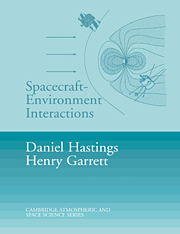Book contents
- Frontmatter
- Contents
- List of Illustrations
- List of Tables
- Preface
- Acknowledgment
- 1 Introduction
- 2 Fundamental Length, Time, and Velocity Scales
- 3 The Ambient Space Environment
- 4 Neutral Gas Interactions
- 5 Plasma Interactions
- 6 The Space Radiation Environment
- 7 Particulate Interactions
- 8 The State of the Art
- References
- Index
5 - Plasma Interactions
Published online by Cambridge University Press: 30 September 2009
- Frontmatter
- Contents
- List of Illustrations
- List of Tables
- Preface
- Acknowledgment
- 1 Introduction
- 2 Fundamental Length, Time, and Velocity Scales
- 3 The Ambient Space Environment
- 4 Neutral Gas Interactions
- 5 Plasma Interactions
- 6 The Space Radiation Environment
- 7 Particulate Interactions
- 8 The State of the Art
- References
- Index
Summary
Spacecraft–Plasma Interactions
The plasma environment that a spacecraft will encounter as a function of orbit is described in Section 3.3. Although the plasma environment is not necessarily the dominant environment in a particular case, it can nevertheless have a profound and destructive effect on a spacecraft or its payload. In particular, major plasma effects follow from the slow accumulation of charge on surfaces. This accumulation of charged particles from the surrounding space plasma on spacecraft surfaces, termed surface charging, produces electrostatic fields that extend from surfaces into space and can result in a number of adverse interactions:
surface arc discharges that generate electromagnetic interference cause surface damage, induce currents in electronic systems, produce optical emissions, and enhance the local plasma density;
enhanced contamination leading to changes in surface, thermal, and optical properties;
a shift of the spacecraft electrical ground, leading to problems with detectors collecting charged particles from the environment; and
coulomb forces on the spacecraft components and materials as well as modifications of the drag coefficient and electromagnetic torques on the spacecraft.
In addition to these concerns, there are some less obvious effects. Of particular concern to the manned spacecraft community, differential charge accumulation between two spacecraft that come into contact (the Shuttle and the station or an astronaut during extra-vehicular activity and the Shuttle) may result in damaging current flows between the spacecraft. These can cause arc discharges, electronic burnout, and other safety hazards.
- Type
- Chapter
- Information
- Spacecraft-Environment Interactions , pp. 142 - 207Publisher: Cambridge University PressPrint publication year: 1996
- 24
- Cited by



